Chicago as you like it
Beaches or museums, baseball or music? This fun-loving metropolis makes it hard to decide what to do first.
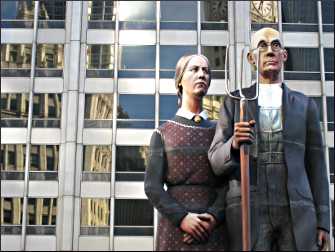
© Beth Gauper
Chicago is like one big theme park. The thing is, you have to bring your own theme.
I have one every time I go there: Blues and bicycling. Museums and dim sum. Skyscrapers and food tours.
That's because the possibilities are endless. There's so much to do in Chicago that it's easy to bounce around like a kid in a candy store, overwhelmed by choices, as time runs out.
So I always zero in on what I can't do at home. How about seeing a Caribbean reef at Shedd Aquarium and Dalis at the Art Institute? Or cruising through an urban landscape shaped by the man who said, "Make no little plans"?
There's certainly nothing little about Chicago. It's big, swaggering, a bit uncouth by reputation — the most American of cities, some say — but also friendly and generous to visitors.
Planning a trip can be daunting. As Mark Twain wrote, "It is hopeless for the occasional visitor to try to keep up with Chicago . . . She is always a novelty, for she is never the Chicago you saw when you passed through the last time."
Here's a head start on finding the Chicago you want.
Bicyclists and skaters
Chicago's lakefront is an incredible treasure. Thanks to department-store magnate Montgomery Ward, who spent a good part of his fortune blocking commercial projects, it's parkland — except for the 34 acres of McCormick Place convention center, now called "Mistake on the Lake."
Along this stretch are countless views and 31 beaches, including Oak Street Beach, at the end of the Magnificent Mile, and Ohio Street Beach, on the north side of Navy Pier.
Bicycling is superb on the 18-mile Lakefront Trail, and bikes and in-line skates can be rented at Millennium Park, Navy Pier and North Avenue Beach.
North of downtown, the trail follows Lincoln Park along six miles of Lake Michigan shoreline, with five beaches, trails, fields and a rock garden and bird sanctuary — plus the free Lincoln Park Zoo, of course.
South of the Loop, it passes the museum campus on its way to Promontory Point, the Museum of Science and Industry and Jackson Park.
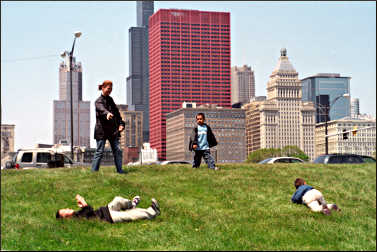
© Beth Gauper
Using Divvy, Chicago's bike-sharing system, allows you to pick up and drop off bikes all around the city, at attractions, beaches and CTA stations.
Divvy bikes also are perfect for exploring the elevated, three-mile 606 Trail through the Logan Square/Wicker Park neighborhood.
For more, see Chicago by bicycle.
Fun for kids
This town is one big field trip for children. Museums — the fabulous Science and Industry and Shedd Aquarium, Adler Planetarium and the Field, home of Sue, the world's largest Tyrannosaurus — are an obvious choice.
Each one has free days, many in winter and some for Illinois residents.
In Grant Park, Maggie Daley Park includes climbing walls, play structures, an "enchanted forest" and a twisting, 20-foot-wide loop that's used for roller-skating in summer and ice-skating in winter.
To the north, the Lincoln Park Zoo is free and lots of fun, with giraffes, hippos, gorillas and room for kids to run. Seven blocks to the west, Oz Park has a wooden-castle playground and comely statues of Dorothy, Toto and crew.
It's free to sightsee at Navy Pier and watch the pirate shows, marching bands and Wednesday and Saturday fireworks. But unwary parents can end up spending plenty on the rides, not to mention souvenirs and snacks.
There are lots of restaurants kids will love, and we're not talking Rock 'n' Roll McDonalds. For more, see Chicago with kids.
Art lovers
Walking through the Art Institute of Chicago is like paging through the syllabus of Art Appreciation 101 — it's filled with world-famous works most people see only in slides or books.
Look, there's "American Gothic"! There's Seurat's "Sunday Afternoon on the Island of the Grande Jatte"! If your jaw doesn't drop at least once, you don't like art. But if you do, it's a don't-miss experience.
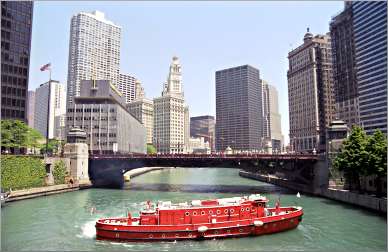
© Beth Gauper
On the Gold Coast, the Museum of Contemporary Art is more avant-garde and hosts many performances and programs, some for children.
Check for free days. Some museums always are free, such as the Smith Museum of Stained Glass Windows, which lines an 800-foot-long series of galleries in Navy Pier's Festival Hall.
Sculptures can be found throughout the city, especially in Millennium Park, in the Loop, on Navy Pier's promenade and in Grant Park.
Music lovers
Every kind of music can be heard in this polyglot city. Witness the various free summer festivals — blues in June, Taste of Chicago in July, jazz over Labor Day and world music in September.
In Millennium Park, there's free music every day in summer, including the free classical concerts held most nights at the Jay Pritzker Pavilion, part of the two-month Grant Park Music Festival.
There are also free concerts at Navy Pier and Daley Plaza.
The Chicago Cultural Center, a Beaux Arts palace at Michigan and Randolph, holds free noon concerts nearly every day year-round: jazz, blues and folk at the ornate Randolph Café, and classical and choral upstairs in Preston Bradley Hall, under the world's largest Tiffany dome.

© Beth Gauper
In the northern suburb of Highland Park, easily reached by Metra Rail, the outdoor Ravinia Festival lasts all summer, featuring classical, pop, country and every other kind of music.
For the latest on concerts and nightlife, stop by the city's two tourism offices, at the Cultural Center and the Chicago Water Works, on Michigan and Pearson, as soon as you hit town.
Foodies and gourmets
It may seem strange to some, but the former "hog butcher to the world" is a major foodie capital.
Two dozen restaurants have Michelin stars and prices to match.
But the lowly tourist as well as low-wage locals can find plenty of great but inexpensive food in ethnic markets, patisseries, bistros and delis. One of the best ways to hit half a dozen in one afternoon is by taking a guided food tour.
There are many, including some that focus just on pizza, but we like the Chicago Food Planet tours. For more, see Into the belly of Chicago.
For one-stop shopping, go to the French Market, just west of the Chicago River between Randolph and Washington, where 30 vendors sell artisan cheese, breads, meats, pastries and chocolate.
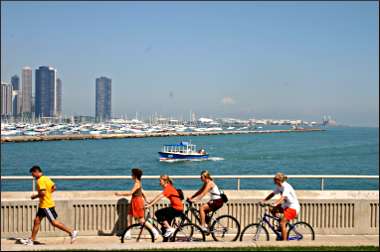
© Beth Gauper
And if you want to try lots of courses at lots of restaurants, visit during Restaurant Week in February.
Fun on the water
Sometimes, people forget that Chicago is virtually a beach town, with 31 miles of sand along Lake Michigan. You can swim and kayak there, and you can take cruises on yachts, schooners and water taxis.
The four-masted schooner Windy is moored at Navy Pier and gives theme cruises.
The newly cleaned-up Chicago River also is a tourist destination, with narrated boat cruises taking tourists past skyscrapers and landmarks. The Chicago Architecture Foundation's 90-minute cruises from the Michigan Avenue bridge are especially popular; reserve early for summer weekends.
Water taxis ply the river and the lakefront between Navy Pier and the Museum Campus, and several companies rent kayaks.
For more, see Paddling the Chicago River.
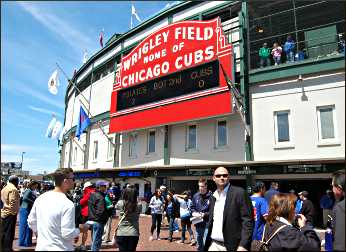
© Torsten Muller
Sports fans
Chicago has not one, but two outdoor stadiums, both easily reached from downtown.
The Cubs play at beloved Wrigley Field, where the upper decks have a view of the lake (take the Red Line train north to Addison), and the White Sox play in concrete Comiskey Park (take the Red Line south to Sox-35th).
Wrigley Field is just a mile west of the tennis courts and marina of Lincoln Park. The nine-hole Sydney Marovitz golf course, a 3,290-yard, par-36 course also known as Waveland, is there, too, with water hazards that include Lake Michigan.
Architecture fans
In Chicago, the buildings have as much personality as the people, and architecture fans from all over the world come to see them.
The city had a golden opportunity to remake itself when the city burned during the Great Fire of 1871, and it became the blank slate on which American architectural aesthetics evolved.

© Beth Gauper
It was a world showplace of architecture during the 1893 Columbian Exposition. But it's best known for the glass-box skyscrapers that sprouted after World War II, especially those of Ludwig Mies van der Rohe, who coined the now-famous truisms "Less is more" and "God is in the details."
The best way to learn more about Chicago's iconic buildings is by going on one of the Chicago Architecture Foundation's walking tours. It also offers tours by motorcoach, bicycle and boat.
In Oak Park, where Frank Lloyd Wright lived and worked, fans can tour his home and studio and see many of the buildings he designed. Wright's Robie House in Hyde Park also is open for tours.
For more, see Skyscraper city and Wright in Oak Park.
Ethnic neighborhoods
If you've done the Loop, the lakefront and the Magnificent Mile, get yourself a transit pass and go exploring.
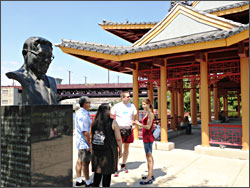
© Beth Gauper
Chicago has lots of interesting ethnic neighborhoods: Chinatown, the Swedish enclave of Andersonville, the East Indian zone on Devon Avenue, Ukrainian Village, Bronzeville.
They're easily explored on your own — mainly, you'll want to eat, with a few breaks for shopping — but if you're interested in history and would like expert narration, the Chicago Architecture Foundation offers tours of some neighborhoods, and Chicago Food Planet offers a great food tour of Chinatown.
For more, see Globe-trotting in Chicago.
Trip Tips: Planning a trip to Chicago
For ways to save money, see Cheap Chicago and Pinching pennies in Chicago.
When to go : In summer, I like to go on Memorial Day and Labor Day weekends, when there are few conventions and the city is relatively quiet.
There's a big festival nearly every weekend. Check this month-by-month list.
Before booking fares to Chicago, first check its convention calendar to see if a huge convention or event is in town; if so, rooms will be hard to find and very expensive.
You'll find good rates in late fall, in the two weeks before Christmas and in winter. For more, see Christmas in Chicago.
Accommodations: You'll be closest to the action in the River North and Loop areas closest to Michigan Avenue. But in the summer, it's also nice to stay in the Lincoln Park neighborhood, close to the lakeshore.
For suggestions, see Where to stay in Chicago.
No matter where you stay, it's easy to get around via Chicago Transit Authority trains or buses.
Dining: It's hard to go wrong. To see what's new, check the listings of Chicago magazine.
And don't neglect the neighborhoods. Some of the best eating is in Old Town and Lincoln Park, just north of downtown.
Tourism information: Choose Chicago, 877-244-2246. I like to visit the visitor center in the Chicago Cultural Center at Randolph and Michigan shortly after I arrive to see what's going on.